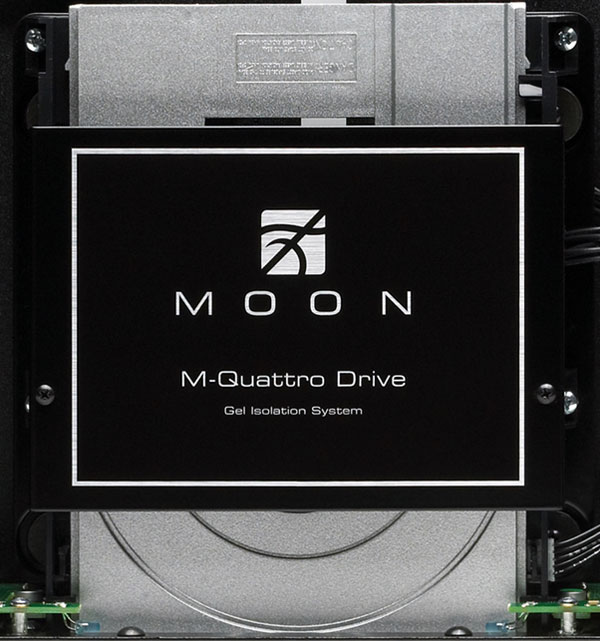Power is everything
Occasionally a SS device will “out tube” a tube component; the 750D is one such device. This Moon is an extremely supple, smooth and rounded-sounding digital player – a dream come true for vinylphiles. I thought the Ayon CD-5 was analogue sounding, but the 750D is much more thick and rich. It has more definition but that definition is not thrust at the listener; it’s subtly spread around the soundstage in a million little details. It’s more “toned down” as opposed to “tipped up.” It’s the extreme quantity of information that keeps it interesting to hear.
How can a player be so detailed and yet so warm and disarming? I believe the power supply is an important factor. When I reviewed the Eastern Electric Minimax DAC, upon suggestion of a designer intimately familiar with it I was encouraged to entirely remove the solid-state Opamps in the EE to make the power supply for the tube output stouter. That allowed the unit’s entire power supply to feed the tube output. This moved the Minimax sonically closer to what I hear from the Moon 750D. Not on a par, but closer. This causes me to conclude the power supply of the Moon 750D is of an entirely higher caliber. I have grave doubts that the 750D would sound as powerful as it does if not for a top quality power supply.
Yet, even with a refined power supply the 750D is subject to the influence of the power cord feeding it. Use of the Wireworld Silver Electra brought more top-end shimmer, but at the expense of a smidgen of precision. The tipped down tonality of the unit can be brought up a bit but you will want to watch that the definition/detail does not change to your disliking. Try a cable like the Silver Electra in several positions in the rig to fine tune the effect since it is possible that the most uplift in the upper midrange and treble may come with a copper cable on the 750D and the silver cable elsewhere. A high total gauge copper cable is my recommendation for retention of stunning tonality and dynamics without forfeiture of finesse.
Going the distance
The Moody Blues is a band which has always resonated with me as their lyrics have been more reflective than reactive. Their music is laced with a relaxed vibe rather than a hard edge. When I am feeling nostalgic, one album I turn to is Long Distance Voyager. I enjoy the subtle interplay between the cover artwork and the songs (surely you noticed long ago the faint image of NASA’s Voyager satellite in the sky above the European village scene, the visual equivalent of the muttering in DSOTM). Released in 1981, the satellite on the cover of the album recognized the flyby of Jupiter by both Voyager 1 and Voyager 2 in the same year. The disc was created when the CD was just getting started as a medium and is not refined by current recording standards. Consequently, this disc played better on the aforementioned systems using solid-state amplification.
While the 750D contains a 32-bit DAC, it does not have the most overt definition of any DAC I have used; that award goes to the Eastern Electric Minimax DAC Plus. But the 750D does have the most weight in terms of bringing gravitas to a performance. Even with the brighter, more detailed solid-state amplification, “ultra-mellow” is what this disc sounds like when played on the Moon 750D. Yet, because of the higher-than-average processing power it was not lethargic. Instead, the warm and smooth blues nature of the group shone through these gentle rock songs. Like the Moody Blues, the Moon 750D is not a flash-bang product; it’s meant to rock you gently, to be sonically and operationally enjoyed for many years without searing your ears. It does not artificially brighten the sound of very warm and laid back recordings. Consequently, I was able to play the entire disc as a mini-concert at higher listening levels without ear fatigue.
I do have a word of caution if you are an audiophile who likes definition and tonality-be-damned. If your goal is the relentless pursuit of every bit, the nitty-gritty gestation and birth of every grain of detail, then the Moon 750D will likely not be sufficiently particular for you. It does not pin you into your seat with a barrage of information; the details are in the mix, but more as a supporting cast rather than the star of the show.
Only a true lunatic sings, “I go out of my mind over you.” Indeed, Sting croons at the moon longing for his lover in a most unnatural manner. On Herbie Hancock’s Possibilities, Sting’s version of “Sister Moon” is preternaturally good in terms of the recording; to my ear more intimate and sensual than the original. However, for all its pristine qualities it lacks flesh and blood, benefitting from the combination of the VAC Phi 200’s as Monos and the 750D.
Pale as moonlight is Sting’s voice without the added heft of the 750D’s DAC. Try as I might I could not get the Minimax, nor any 24-bit DAC, to mimic the weighting afforded through the 750D. Even the highly engaging, reference-quality Ayon CD-5 fell short not only of the definition, but especially the substantive sound of the 750D. Sting uses orchestration quite a bit and it benefitted from the additional foundation provided by the VAC/Moon combination. While the bass was not laser sharp it was robust and full. The 750D should be a safe choice for systems having a high degree of detail/definition meandering into edginess. It will tone down the etched treble and plump the voices to keep them from sounding anorexic.
- ← Previous page
- (Page 3 of 4)
- Next page →


